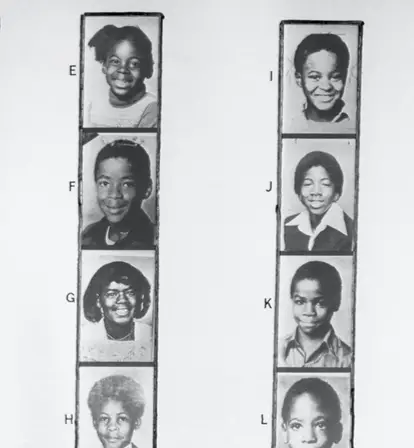Though Wayne Williams was convicted in two cases, who was behind the rest of the Atlanta murders that left at least 28 dead from 1979 to 1981?
In the late 1970s and early 1980s, a mysterious killer terrorized Black communities in Atlanta. One by one, Black children and young adults were being kidnapped and turning up dead days or weeks later. These grisly cases would later become known as the Atlanta Child Murders.
Police eventually arrested a local man named Wayne Williams in connection to the heinous crimes. But Williams was only ever convicted of two murders — far less than the 29 slayings he was implicated in. Furthermore, he was found guilty of killing two men in their 20s, not children.
Although the homicides appeared to stop after Williams was arrested, some believe that he was not responsible for the Atlanta Child Murders — including some of the victims’ families. The tragic case was later explored in the Netflix series Mindhunter in 2019. And that same year, the real Atlanta Child Murders case was reopened in the hopes of finding the truth.
But will the city’s new investigation truly bring justice to the children? Or will it just lead to more questions without answers?
The Atlanta Child Murders Of The 1970s and 1980s

AJCThe victims of the Atlanta murders were all Black children, adolescents, and young adults.
On a balmy summer day in July 1979, the first body linked to the Atlanta Child Murders case was discovered. Thirteen-year-old Alfred Evans was found in a vacant lot, his cold body shirtless and barefoot. He had been killed by strangulation. Tragically, he had disappeared just three days earlier.
But as police were investigating the apparent crime scene in the vacant lot, they couldn’t help but notice a strong odor emanating from nearby vines. And they would soon discover the body of another Black child — 14-year-old Edward Hope Smith. Unlike Evans, Smith had been killed by gunshot. But eerily, he was found just 150 feet away from Evans.
The deaths of Evans and Smith were brutal. But authorities weren’t too alarmed — they simply wrote off the murder cases as being “drug-related.” Then, a few months later, more Black youths started turning up dead.
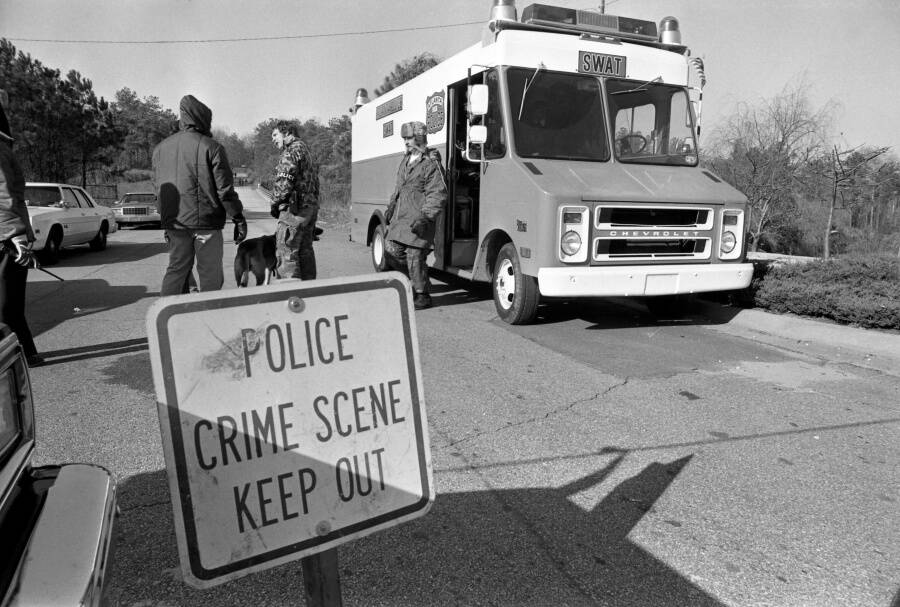
Getty ImagesPolice officers, firefighters, and volunteers combed the city in search of evidence in the Atlanta Child Murders.
The next bodies uncovered were 14-year-old Milton Harvey and 9-year-old Yusuf Bell. Both children had been strangled to death. Bell, the fourth victim, had been living in a housing project just four blocks away from where his body was found. His death hit the local community especially hard.
“The whole neighborhood cried ’cause they loved that child,” said Bell’s neighbor, who knew he enjoyed math and history. “He was God-gifted.”
Four murdered Black kids in the span of a few months raised suspicion among the victims’ families that the crimes could be related. Still, the Atlanta Police did not establish any official links between the murders.

AJCYusuf Bell, 9, was the fourth victim discovered during the Atlanta Child Murders case.
By March 1980, the death toll had reached six. At this point, it became increasingly clear to residents that their communities were in serious danger. Parents started imposing curfews on their children.
And yet, victims kept turning up. They were almost all boys, except for two girls. And though a couple of victims linked to the case were later identified as adult men, most of them were children. And all of them were Black.
African American communities in and around Atlanta were gripped with fear and anxiety, but they were also extremely frustrated — since the Atlanta Police had still not drawn a connection between the cases.
Black Mothers Rally Against Police Inaction

Georgia State University Library ArchiveCamille Bell, the mother of Yusuf Bell, joined forces with other parents of victims to form the Committee to Stop Children’s Murders.
Even with heightened vigilance in the community, kids kept disappearing. In March 1980, Willie Mae Mathis was watching the news with her 10-year-old son Jefferey when they both saw investigators moving the body of one of the victims. She warned her young son about interacting with strangers.
“He said, ‘Mama, I don’t do that. I don’t talk to strangers,'” Mathis recalled. Tragically, the very next day, Jefferey went to the corner store to get a loaf of bread — but he never made it there. His remains were found a year later.
The reality that Black youths were being preyed on and murdered in Atlanta sent shockwaves through the city’s communities.
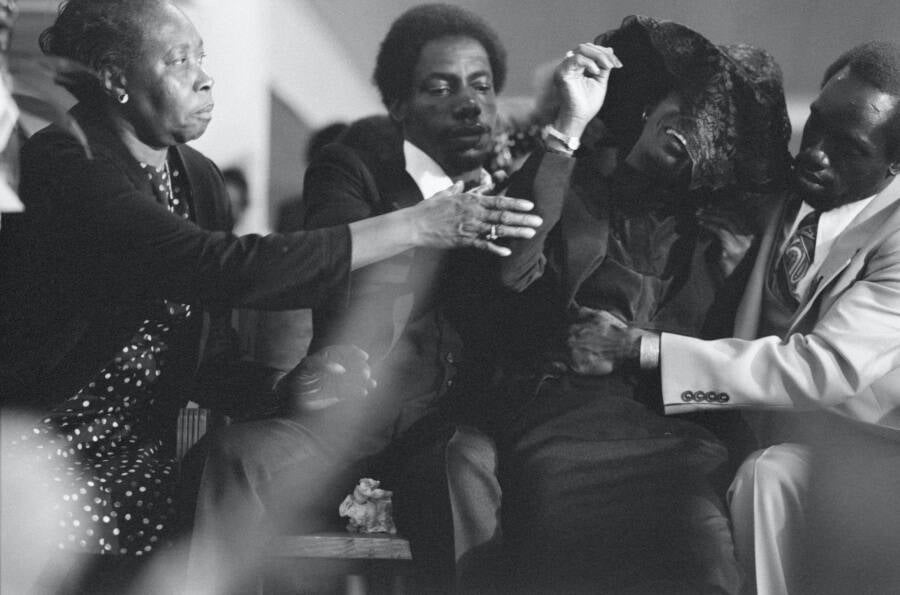
Bettmann/Contributor/Getty ImagesDoris Bell, the mother of another Atlanta murder victim, Joseph Bell, cries during her son’s funeral.
Even more chilling, the circumstances of the deaths varied in the Atlanta Child Murders. Some children died of strangulation, while others died of stabbing, bludgeoning, or gunshot wounds. Worse yet, the cause of death for some of the victims, like Jefferey Mathis, was left undetermined.
By May, the grieving families had still not received any significant updates on the investigation. Frustrated by Atlanta Mayor Maynard Jackson’s inaction and the reluctance of the Atlanta Police to recognize the murders as connected, the community began organizing on their own.
In August, Camille Bell, the mother of Yusuf Bell, joined forces with other parents of victims and formed the Committee to Stop Children’s Murders. The committee was supposed to act as a community-powered coalition to push for accountability over the stalled investigations of the slain kids.

Bettmann/Contributor/Getty ImagesA student is comforted by his teacher during the funeral of his friend Patrick Baltazar, 11, who was murdered.
Incredibly, it worked. The city significantly increased both the size of the investigation’s task force and the total reward money for tips. Bell and the committee members also successfully galvanized the community to become active in safeguarding their neighborhoods.
“We were encouraging people to get to know their neighbors,” Bell told People magazine. “We were encouraging the busybodies to go back to dipping into everybody’s business. We were saying that if you tolerated crime in your neighborhood you were asking for trouble.”
According to Bell, the murder of 13-year-old Clifford Jones — a visitor from Cleveland — also helped push Atlanta’s authorities into action. After all, the murder of a tourist had made national news.
Meanwhile, local citizens armed themselves with baseball bats, volunteering for the city’s neighborhood patrol. And other volunteers joined the citywide search to uncover clues that could help solve the case.
A few months after the committee’s formation, Georgia officials requested that the FBI join the investigation. Five of the nation’s top homicide detectives were brought in as consultants. And two U.S. Justice Department officials were also dispatched to the city to provide support.
At long last, authorities were taking the case seriously.
The Arrest And Conviction Of Wayne Williams For Some Of The Atlanta Murders
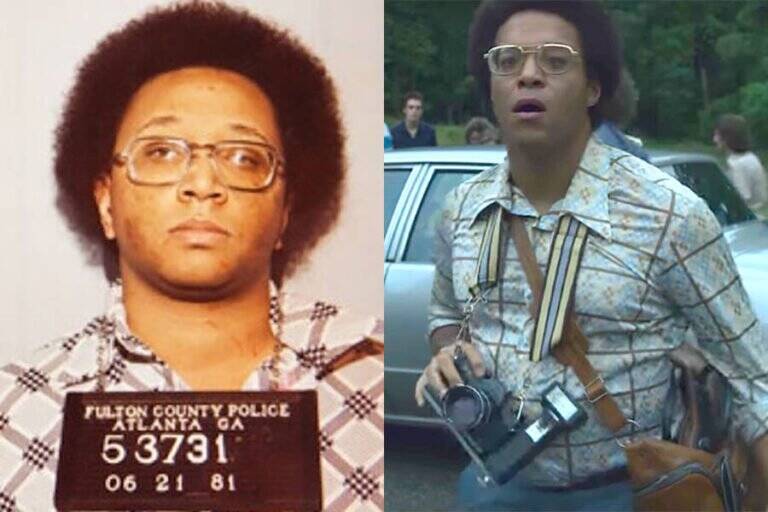
Wikimedia Commons/NetflixWayne Williams after his arrest (L), and Williams portrayed by Christopher Livingston in Mindhunter (R).
From 1979 to 1981, 29 Black children and young adults were identified as victims in the Atlanta Child Murders. On April 13, 1981, FBI Director William Webster announced that the Atlanta Police had identified the killers — seemingly indicating multiple perpetrators — of four of the slain children. However, authorities lacked sufficient evidence to file charges.
Then, a month later, a police officer working the department’s stakeout operation along the Chattahoochee River heard a splashing sound. The officer then saw a station wagon pass overhead on the South Cobb Drive Bridge. Suspicious, he decided to stop the driver for questioning. That driver was a 23-year-old man named Wayne Williams.
The officer let Williams go — but not before grabbing a few fibers from his car. And just two days later, the body of 27-year-old Nathaniel Carter was discovered downstream. Eerily, the body wasn’t far from where the body of 21-year-old Jimmy Ray Payne had been found just a month earlier.
In June 1981, Wayne Williams was arrested in connection to the deaths of Payne and Carter. He would later be convicted of the murders of both men, who were among the few adult victims in the Atlanta murders case. And Williams was sentenced to life in prison. But although he was accused of being the Atlanta child killer, he was never convicted of any other murders.
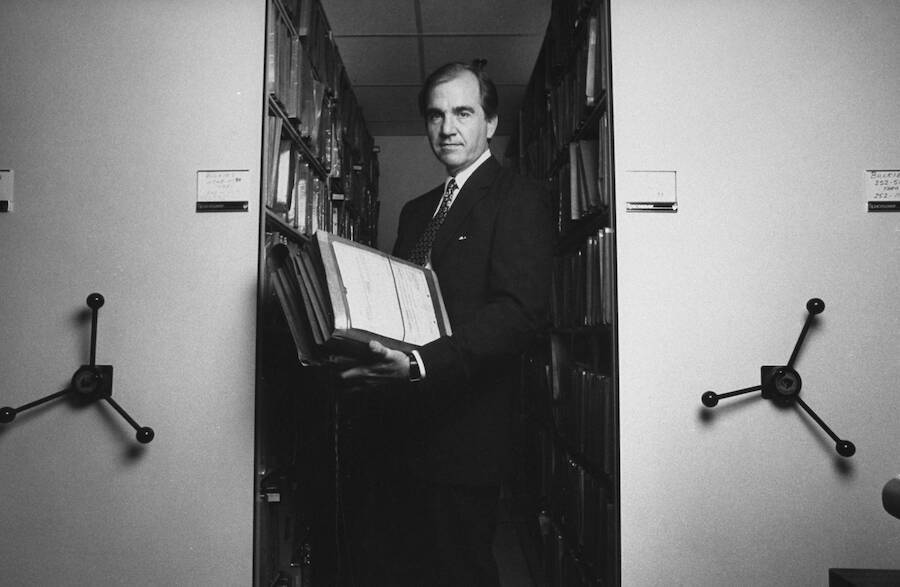
Getty ImagesFamed FBI profiler John Douglas believed that Wayne Williams was responsible for some of the Atlanta murders — but perhaps not all of them.
Since Wayne Williams’ arrest, there have been no more related killings — at least none that were reported as such. But there are some who remain skeptical that Williams was a serial killer, including many of the victims’ families. And to this day, Williams maintains his innocence.
Additionally, Wayne Williams’ conviction relied on a few strands of fiber that the prosecution claimed were found on the bodies of Carter and Payne. Apparently, these fibers matched a rug in Williams’ car and a blanket in his home. But fiber evidence is often considered less than reliable. And discrepancies in witness testimonies cast more doubt on Williams’ guilt.
A number of alternative theories have cropped up throughout the years, ranging from a pedophile ring to the government conducting horrific experiments on Black children. But one of the most widely believed theories is that the Ku Klux Klan was behind the Atlanta Child Murders.
In 1991, it was revealed that a police informant allegedly heard a KKK member named Charles Theodore Sanders verbally threaten to choke a Black teenager named Lubie Geter after the boy accidentally scratched his truck — while the Atlanta Child Murders were still happening.
Horrifically, Geter ended up becoming one of the victims. His body was discovered in 1981, just weeks after Sanders’ threat. He had been strangled — and his genitals, lower pelvic area, and both feet were all missing.

AJCA 1981 article from the Atlanta Journal-Constitution after Wayne Williams’ conviction.
Years later, a 2015 report by Spin magazine uncovered shocking details of a high-level secret investigation by the Georgia Bureau of Investigation and various other law enforcement agencies. This investigation apparently found that Sanders — and his white supremacist family members — planned to kill more than two dozen Black children to incite a race war in Atlanta.
Evidence, witness accounts, and informant reports suggested a link between the Sanders family and Geter’s death — and possibly 14 other child murders. So to “keep the peace” in the city, investigators allegedly decided to suppress evidence of possible KKK involvement in the Atlanta Child Murders.
But despite authorities’ efforts to conceal evidence linked to the KKK, many of the city’s Black residents already — and still — suspected that the white supremacist group was responsible for the crimes.
However, officials involved in the primary investigation maintain that they had enough evidence to connect Wayne Williams to the killings. To this day, Williams remains in prison — and he’s been denied parole multiple times.
In a rare interview in 1991, Williams revealed that he had befriended some of the brothers of the victims — as they had ended up in the same prison. He also said that he had been in touch with some of the victims’ mothers. He said, “I truly hope they find out who killed their children.”
Why The Atlanta Child Murders Case Was Reopened
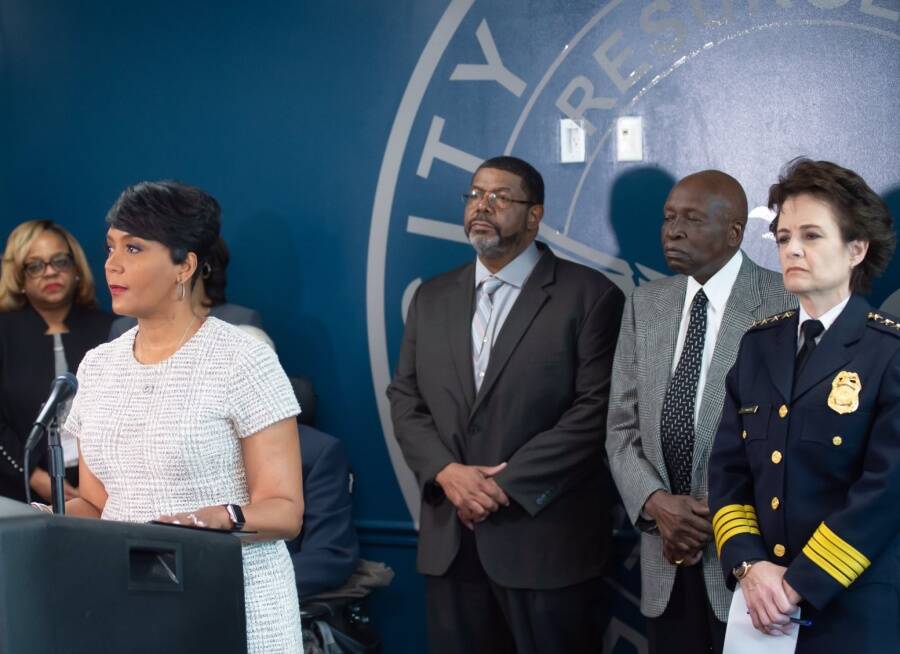
Keisha Lance Bottoms/TwitterAtlanta Mayor Keisha Lance Bottoms announces the reopening of the Atlanta Child Murders investigation in 2019.
Despite the countless theories about what really happened to Atlanta’s children, it’s clear that much was left unsettled and unresolved. That’s a big reason why the case has been reopened.
In March 2019, Atlanta Mayor Keisha Lance Bottoms — who grew up during the height of the Atlanta Child Murders — reopened the case. Bottoms said that evidence should be retested using the latest forensic technology, which was not available during the investigation four decades ago.
In an emotional interview following the announcement, Bottoms recalled what it was like growing up during this terrifying time: “It was like there was a boogeyman out there, and he was snatching Black children.”
Bottoms added, “It could have been any of us… I hope that [reexamining the case] says to the public that our children matter. African American children still matter. They mattered in 1979 and [they matter] now.”
Not everyone shared the mayor’s conviction that the case needed another look. In fact, some believe it’s basically already solved.
“There was other evidence, more fibers and dog hairs brought into court, along with witness testimony. And there is the inescapable fact that Wayne Williams was on that bridge, and two bodies washed up days later,” said Danny Agan, a retired Atlanta homicide detective who investigated three of the murders. “Wayne Williams is a serial killer, a predator, and he did the bulk of these murders.”
While some like Agan insist that Williams was the Atlanta child murderer, Police Chief Erika Shields does believe that the Atlanta Child Murders case deserves another investigation.
“This is about being able to look these families in the eye,” Shields told the New York Times, “and say we did everything we could possibly do to bring closure to your case.”
In recent years, renewed interest in the Atlanta Child Murders has also permeated pop culture. The infamous case became the main plot in season two of the Netflix crime series Mindhunter. The series itself was largely inspired by a book of the same name, written by former FBI Agent John Douglas — who is considered a pioneer in criminal profiling.

NetflixActors Holt McCallany, Jonathan Groff, and Albert Jones portray the FBI agents involved in the Atlanta Child Murders case in Mindhunter.
As for Douglas, he believed that Wayne Williams was responsible for some of the murders — but perhaps not all of them. He once said, “It isn’t a single offender, and the truth isn’t pleasant.”
Currently, investigators are examining and reexamining every bit of evidence available. But it’s difficult to say whether the renewed efforts will yield any significant closure for the families and the city at large.
“The question will be, who, what, when, and why. That’s what it’s always going to be,” said Lois Evans, the mother of the first victim, Alfred Evans. “I’m blessed to still be here. Just [to] wait to see what the end will be, before I leave this Earth.”
She added: “I think it will be part of history that Atlanta will never forget.”
After reading about the Atlanta Child Murders, discover the true story behind Jerry Brudos, the shoe fetish killer in ‘Mindhunter.’ Then, take a look at 11 famous murders that remain bone-chilling to this day.
